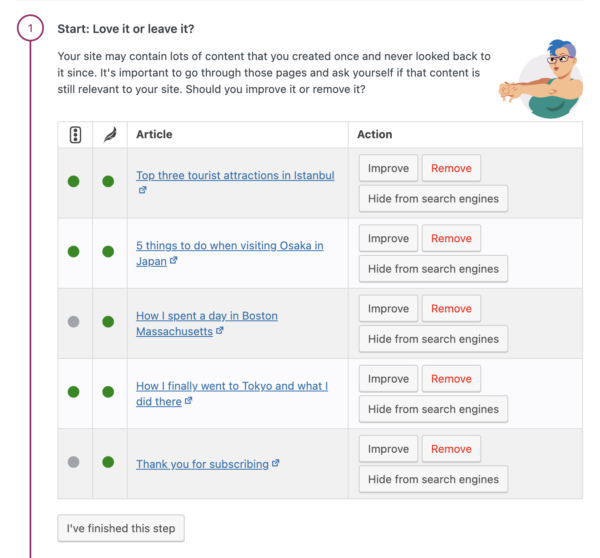Update or delete? Cleaning up old content on your site

Sometimes, content on your website becomes irrelevant or out of date, and you need to decide whether to update it or delete it. It’s part of your regular content maintenance activities. There are several ways to go about this and this article helps you decide what’s the best solution for your old content.
Before we start, you might be interested to know that our Orphaned content SEO workout can do a lot to help you clean up your old content. Starting with a list of pages that don’t have any internal links pointing towards them (the so-called ‘orphaned content‘), we’ll walk you through 4 simple steps to give your content a good spring cleaning!
Update old content that is still valid
Let’s start with an example: On our blog, we have an article on meta descriptions that needs constant updating to keep it relevant. We just have to make sure it stays up to date with all the changes Google keeps making to the way it handles meta descriptions. Sometimes it seems they can be a bit longer and sometimes they seem to go back to the old length again.
Our post helps writers and editors to write meta descriptions, even though the advice changes over time. Although the article itself might be what we call cornerstone content, its content must be updated to keep up with the latest standards – constantly.
You can easily create new, valuable content from your old posts if you update it and make it current again: old wine in new bottles, as the saying goes. You could, for example, merge three old blog posts about the same subject into one new post or simply replace older parts of your post with updated content.
Read more: How to update your content in 10 steps (and make it better) »
Pro tip: Creating a clone of your post with Yoast Duplicate Post makes this process a lot easier. The Rewrite & Republish feature allows you to make a draft copy of your post, work on it and publish the updated version without too much hassle. Your updated post will replace the original one, and the draft will be deleted for you.
Keep reading: Keep your content fresh and up to date »
Delete irrelevant posts or pages
It’s likely that you have old posts or pages on your site that you don’t need anymore. Think along the lines of a blog post about a product you stopped selling a while ago and have no intention of ever selling again. Or an announcement of an event that took place a long time ago. You might also have old pages with little or no content – so-called thin content pages.
These are just some examples, but I’m sure you know which posts and/or pages I’m talking about. This old content adds no value anymore, now or for the foreseeable future. In that case, you need to either tell Google to forget about these old posts or pages or give the URL another purpose.
When I talk about deleting old content, I don’t mean just pressing “delete” and then forgetting about it. If you do that, the content might show up in Google for weeks after deletion. The URL might actually have some link value as well, which would be a shame to waste.
So, what should you do? Here are two options:
“301 Redirect” the old post to a related one
When a URL still holds value because, say, you have a number of quality links pointing to that page, you want to leverage that value by redirecting the URL to a related one. With a 301 Redirect you’ll tell search engines and visitors there’s a better or newer version of this content elsewhere on your site. The 301 redirect automatically sends people and Google to this page.
Say you have an old post on a specific dog breed. You need to delete it, so the logical next step would be to redirect that post to a newer post about this dog breed. If you don’t have that post, choose a post about the closest breed possible. Redirecting to a relevant category might be an option in some edge cases but this should not be standard practice. What’s more, redirecting to the homepage should be out of the question — this is an SEO anti-pattern.
Creating a 301 Redirect (for instance in WordPress) isn’t hard, but doing it with Yoast SEO Premium is easy as pie. If you don’t have it yet, find out about all the extras that are in Yoast SEO Premium here.
Tell search engines the content is intentionally gone
If there isn’t a relevant page on your site you can redirect to, it’s wise to tell Google to forget about your old post entirely by serving a “410 Deleted” status to Google. This status code will tell Google and visitors the content didn’t just disappear; you’ve deleted it with a reason.
When Google can’t find a post, the server will usually return a “404 Not Found” status to the search engine’s bot. You’ll also find a 404 crawl error in your Google Search Console for that page. Eventually, Google will work it out and the URL will gradually vanish from the search result pages. But this takes time.
The 410 is more powerful in the sense that it tells Google that the page is gone forever, never to return. You deleted it on purpose, period. Google will act on that faster than with a 404. Read up about the server status codes if this is all gibberish to you.
Read on: How to properly delete a page from your site »
Do you have old content to deal with?
Cleaning up old content should be part of your content maintenance routine to keep your website fit. If you don’t go through your old posts regularly, you’re bound to run into issues sooner or later. You might show incorrect information to visitors or hurt your own rankings by having too many pages about the same topic, increasing chances of keyword cannibalization, which is a lot of work to find and fix later on. So prune your content regularly and decide what to do: update, merge or delete.
Clean up your orphaned content with Yoast SEO Premium
A great place to start is with your orphaned content, which is content on your pages or posts that have zero internal links to them. You might be surprised, but most of us have orphaned content on our website. Which is a shame, because both your audience and Google won’t be able to find this content. Meaning that you might be missing out on a great place in the search results and lots of traffic.
To help you clean up your old content, we’ve created an SEO workout that identifies your pages and posts that don’t have any links and walks you through four simple steps to fix them. These steps allow you to decide whether you want to update or delete a certain page: love it or leave it. And when you do decide to update it, it also suggests pages or posts from which you can link to this updated content. Helping you fix your orphaned content and update it at the same time!

You will need Yoast SEO Premium if you want to use this workout. You might want to try our other internal linking SEO workout to help you rank higher with your best content, also available in the Premium plugin:
Unlock our SEO workouts with Yoast SEO Premium
Get Yoast SEO Premium and enjoy access to all our best SEO tools, training and SEO workouts!
If you’re not sure whether you’re managing your site’s content well enough right now, we also have a content SEO fitness test that tells you if your content needs some more work to get SEO fit. Make sure to give it a go and find out where you stand. Good luck cleaning up!
Keep on reading: Save time in SEO with these tips »

